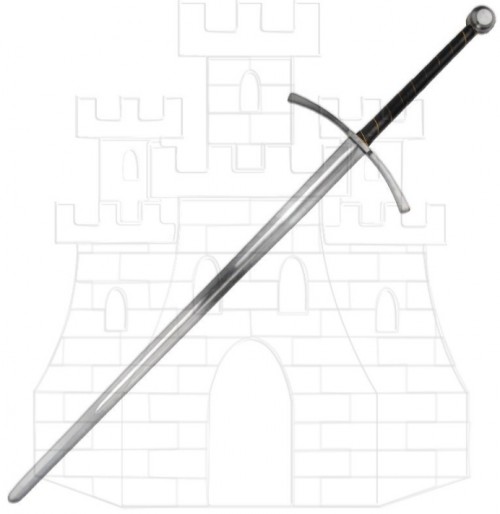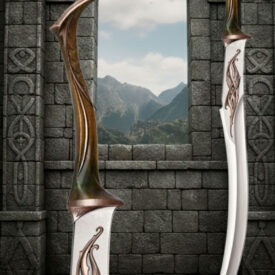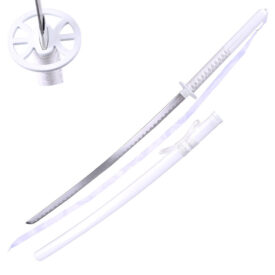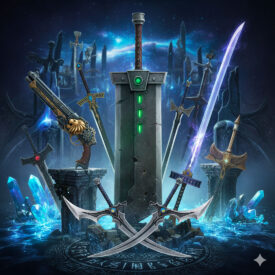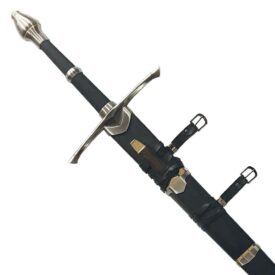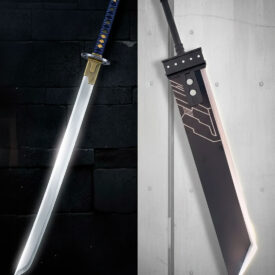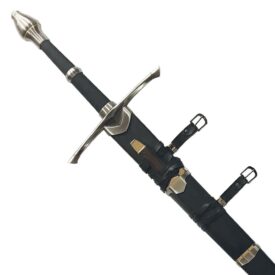The Gothic greatsword is one of the most iconic pieces of medieval weaponry: a large, rising sword that combines martial functionality with the aesthetic of European Gothic art. In this article, we delve into its history, design, handling techniques, maintenance, and how to choose a functional or decorative replica. You will learn to distinguish an authentic Gothic greatsword, what to look for when buying, and why it remains relevant in historical reenactments and collections.
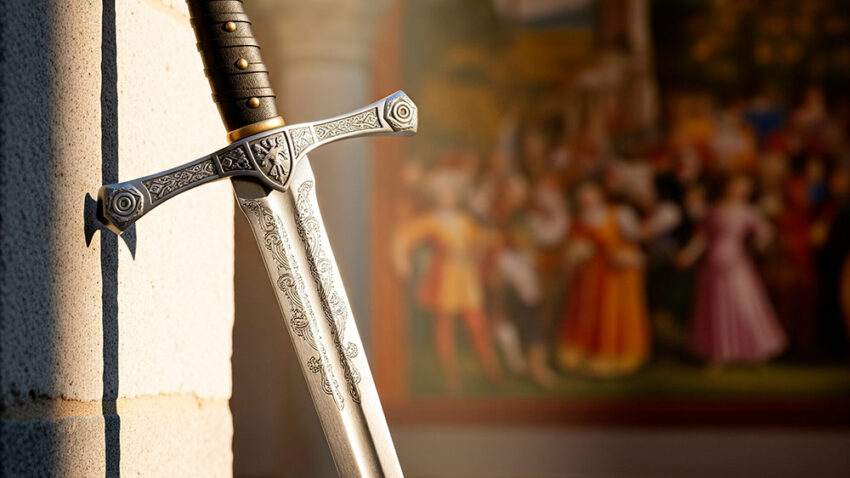
History and context of the Gothic greatsword
The term “Gothic” refers to an artistic and cultural period that developed in Europe from the mid-12th century until the beginning of the Renaissance. The Gothic greatsword was integrated into this temporal framework as an evolution of longswords: it increased in size and decorative detail, reflecting the aesthetic sensibility of the era.
During the 13th to 15th centuries, battles and formations changed, and armor evolved. The greatsword — also called a montante sword — was consolidated as a weapon for breaking defenses and for mounted or foot combat, with variants that required one- or two-handed grips. In addition to its practical function, many Gothic swords served as a status symbol; their decoration (engravings, pommels with heraldry, complex quillons) was a visual language of prestige.
How the Gothic style fits into sword forging
The Gothic style influenced the lines, floral and geometric motifs, and technical perfection. Swords made under this aesthetic feature elongated proportions, refined finishes, and often armorer’s marks or religious and heraldic symbols engraved on the blade or pommel.
Technical characteristics of the Gothic greatsword
To identify a Gothic greatsword, it is advisable to look at several technical elements that define its handling and aesthetics.
- Blade material: usually tempered carbon steel that offers resilience in real combat and a faithful appearance in functional replicas.
- Overall length: variants can exceed 150 cm in historical replicas; however, practical and documented greatswords usually measure between 120 and 160 cm depending on the era and function.
- Blade length: often around 100–115 cm in large models; a longer blade facilitates wide-arc cuts and deep thrusts.
- Hilt: can be one- or two-handed; long hilts allow for two-handed grip for maximum leverage.
- Guard and pommel: robust guard for protection and balance; the pommel acts as a counterweight and is usually decorated.
- Blade shape: double-edged with a robust profile and defined bevel; some have a central fuller to lighten weight.
- Weight: varies widely: functional replicas weigh between 1.5 kg and more than 3 kg, depending on length and materials.
A real example: the best-known functional Gothic greatsword in current catalogs reaches 155 cm in total length, with a high carbon steel blade, 111.5 cm blade, 35 cm hilt, and a weight close to 3.1 kg. These figures illustrate why technique and strength are required for its handling.
Terminology and synonyms
When searching for information or buying, you will find similar terms: “Gothic sword”, “Gothic longsword”, “medieval greatsword”, “Gothic two-handed sword”, or “functional Gothic greatsword”. Integrating these variants into the reading helps to understand the broad family of weapons that share origin and form.
Historical use and modern application
Historically, the Gothic greatsword was used by impassable combinations of knights and infantry foot soldiers. Its size made it useful for reaching vulnerable points in armor or outflanking formations. The technique of use combined cuts, thrusts, and blows with the guard.
Today the Gothic greatsword lives a second life on several fronts:
- Historical reenactment (HEMA and historical combat): it is used to practice historical two-handed techniques.
- Reenactment and LARP: safe or semi-functional versions adapted to events.
- Collecting: decorative and functional replicas for display.
- Cultural and audiovisual scene: cinema, series, and video games have revived interest in these swords.
Comparison: Gothic greatsword versus other swords
To better understand its peculiarities, it is convenient to compare it with related pieces: the longsword, the claymore, and the zweihänder. The following comparative table highlights dimensions, uses, and particularities. The table is responsive through a container with horizontal overflow to adapt to small screens.
| Type | Typical Length | Approximate Weight | Main Use | Notes |
|---|---|---|---|---|
| Gothic Greatsword | 120–160 cm | 1.5–3+ kg | Heavy combat, breaking formations, symbolism | Double-edged blade, long hilt, Gothic aesthetic |
| Longsword | 100–130 cm | 1–1.8 kg | Versatile: cutting, thrusting, HEMA techniques | More maneuverable, technical orientation |
| Claymore | 120–160 cm | 2–3 kg | Infantry and reach recognition | Scottish design, characteristic hilt |
| Zweihänder | 150–210 cm | 2.5–5+ kg | Anti-pike tactics and suppression | Extreme variant of the greatsword |
The Gothic greatsword falls between the longsword and the zweihänder in terms of size and purpose: it is large enough to inflict impact damage and penetrate defenses, but its Gothic design distinguishes it by ornaments and proportions that prioritize a balance between cutting and thrusting.
How to choose a Gothic greatsword: buying guide
If you are looking to buy a Gothic greatsword, consider these practical criteria that will help you decide between a decorative piece and a functionally safe one:
- Intended use: collection, display, HEMA, reenactment, or LARP? Needs vary: real functionality requires tempered carbon steel; decoration allows for less resistant materials.
- Measurements and weight: adjust the blade and hilt length to your height and strength; a physical test is ideal for heavy pieces.
- Finish and decoration: consider whether you prefer period-accurate engravings or a more neutral finish.
- Warranty and armorer’s guarantee: verify origin and return policies.
- Value for money: a good functional replica justifies investment for safety and longevity.
In our online store, we offer a selection of functional and decorative Gothic replicas with clear specifications to help you choose according to your profile and intended use.
Maintenance and conservation
Maintenance is key to preserving a carbon steel sword:
- Always dry the blade after handling it.
- Apply a light layer of protective oil to prevent oxidation.
- Store the sword in a dry place and avoid damp scabbards that accumulate condensation.
- For functional pieces, check the edge condition and perform professional sharpening when necessary.
Manufacturers, replicas, and relevant brands
The current market combines large manufacturers, artisan armorers, and specialized stores. There are mass-produced models that faithfully reproduce Gothic proportions and artisan pieces with traditional forging.
When looking for manufacturers, consider:
- The reputation of the armorer or brand.
- Clear technical specifications (steel type, tempering, warranty).
- Opinions from other buyers and real photographic samples.
If you are looking for quality functional replicas, our online store has catalogs with measurements and technical data, and advice to help you select the right piece.
Practical tips for handling and safety
Handling a Gothic greatsword requires technique and adherence to safety rules. Some basic tips:
- Train with HEMA instructors before trying combat with heavy greatswords.
- Use appropriate protection on your wrists, forearms, and body when practicing.
- Practice controlled cuts and thrusts, progressing in weight and speed.
- Do not use a decorative replica for impact practices: they are not designed to withstand blows.
Recommended initial exercises
If you are a beginner, start with a practice sword or a greatsword with a non-aggressive edge and work on:
- Basic positions and footwork.
- Balance exercises to correctly hold the long hilt.
- Static and moving cuts with distance control.
Related products
VIEW OTHER FUNCTIONAL SWORDS | VIEW MORE SWORDS
Gothic pieces are not just museum objects: they are tools loaded with history and technique that can be part of a collection, a sports practice, or an audiovisual production. When choosing, prioritize technical information and safety. A well-made and maintained Gothic greatsword is an investment that combines beauty, tradition, and functionality. If you are looking for authentic pieces or advice, visit our online store where you will find models with detailed technical specifications and support for your purchase.
